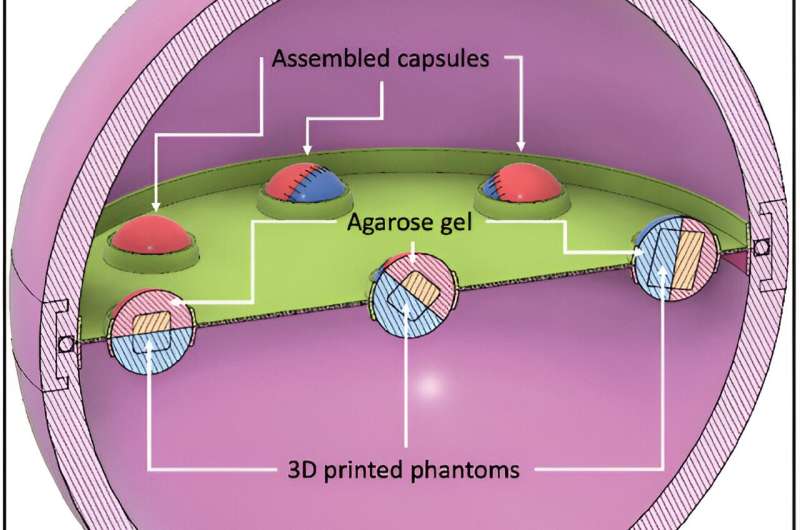World’s first high-resolution brain model created with 3D printer

In a joint venture between TU Wien and MedUni Vienna, the world’s first 3D-printed “mind phantom” has been developed, which is modeled on the construction of mind fibers and could be imaged utilizing a particular variant of magnetic resonance imaging (dMRI).
As a scientific workforce led by TU Wien and MedUni Vienna has now proven, these mind fashions can be utilized to advance analysis into neurodegenerative ailments comparable to Alzheimer’s, Parkinson’s and a number of sclerosis. The analysis was revealed within the journal Superior Supplies Applied sciences.
Magnetic resonance imaging (MRI) is a extensively used diagnostic imaging method that’s primarily used to look at the mind. MRI can be utilized to look at the construction and performance of the mind with out the usage of ionizing radiation. In a particular variant of MRI, diffusion-weighted MRI (dMRI), the course of the nerve fibers within the mind may also be decided. Nonetheless, it is rather tough to appropriately decide the course of nerve fibers on the crossing factors of nerve fiber bundles, as nerve fibers with completely different instructions overlap there.
In an effort to additional enhance the method and check evaluation and analysis strategies, a world workforce in collaboration with the TU Wien and the Medical College of Vienna developed a so-called “mind phantom,” which was produced utilizing a high-resolution 3D printing course of.
Tiny dice with microchannels
Researchers from the Medical College of Vienna as MRI consultants and TU Wien as 3D printing consultants labored carefully with colleagues from the College of Zurich and the College Medical Heart Hamburg-Eppendorf. In 2017, a two-photon polymerization printer was developed at TU Wien that permits upscaled printing. The ensuing patent varieties the premise for the mind phantom that has now been developed and is being supervised by TU Wien’s Analysis and Switch Help workforce.
Visually, this phantom doesn’t have a lot to do with an actual mind. It’s a lot smaller and has the form of a dice. Inside it are extraordinarily fantastic, water-filled microchannels the dimensions of particular person cranial nerves. The diameters of those channels are 5 instances thinner than a human hair.
In an effort to imitate the fantastic community of nerve cells within the mind, the analysis workforce led by first authors Michael Woletz (Heart for Medical Physics and Biomedical Engineering, MedUni Vienna) and Franziska Chalupa-Gantner (3D Printing and Biofabrication analysis group, TU Wien) used a somewhat uncommon 3D printing methodology: two-photon polymerization. This high-resolution methodology is primarily used to print microstructures within the nanometer and micrometer vary—not for printing three-dimensional constructions within the cubic millimeter vary.
In an effort to create phantoms of an acceptable measurement for dMRI, the researchers at TU Wien have been engaged on scaling up the 3D printing course of and enabling the printing of bigger objects with high-resolution particulars. Extremely scaled 3D printing gives the researchers with superb fashions that—when considered below dMRI—make it attainable to assign numerous nerve constructions.
Michael Woletz compares this strategy to enhancing the diagnostic capabilities of dMRI with the best way a cell phone digital camera works. “We see the best progress in pictures with cell phone cameras not essentially in new, higher lenses, however within the software program that improves the captured pictures.
“The scenario is analogous with dMRI: utilizing the newly developed mind phantom, we are able to alter the evaluation software program way more exactly and thus enhance the standard of the measured knowledge and reconstruct the neural structure of the mind extra precisely,” says Woletz.
Mind phantom trains evaluation software program
The genuine replica of attribute nerve constructions within the mind is subsequently vital for “coaching” the dMRI evaluation software program. The usage of 3D printing makes it attainable to create various and complicated designs that may be modified and customised. The mind phantoms thus depict areas within the mind that generate notably complicated alerts and are subsequently tough to investigate, comparable to intersecting nerve pathways.
In an effort to calibrate the evaluation software program, the mind phantom is subsequently examined utilizing dMRI and the measured knowledge is analyzed as in an actual mind. Because of 3D printing, the design of the phantoms is exactly recognized and the outcomes of the evaluation could be checked. TU Wien and MedUni Vienna had been in a position to present that this works as a part of the joint analysis work.
The phantoms developed can be utilized to enhance dMRI, which might profit the planning of operations and analysis into neurodegenerative ailments comparable to Alzheimer’s, Parkinson’s and a number of sclerosis.
Regardless of the proof of idea, the workforce nonetheless faces challenges. The most important problem in the meanwhile is scaling up the tactic. “The excessive decision of two-photon polymerization makes it attainable to print particulars within the micro- and nanometer vary and is subsequently very appropriate for imaging cranial nerves.
“On the identical time, nevertheless, it takes a correspondingly very long time to print a dice a number of cubic centimeters in measurement utilizing this system,” explains Chalupa-Gantner. “We’re subsequently not solely aiming to develop much more complicated designs, but in addition to additional optimize the printing course of itself.”
Extra data:
Michael Woletz et al, Towards Printing the Mind: A Microstructural Floor Fact Phantom for MRI, Superior Supplies Applied sciences (2024). DOI: 10.1002/admt.202300176
Vienna College of Know-how
Quotation:
World’s first high-resolution mind mannequin created with 3D printer (2024, March 21)
retrieved 21 March 2024
from https://medicalxpress.com/information/2024-03-world-high-resolution-brain-3d.html
This doc is topic to copyright. Other than any honest dealing for the aim of personal examine or analysis, no
half could also be reproduced with out the written permission. The content material is supplied for data functions solely.